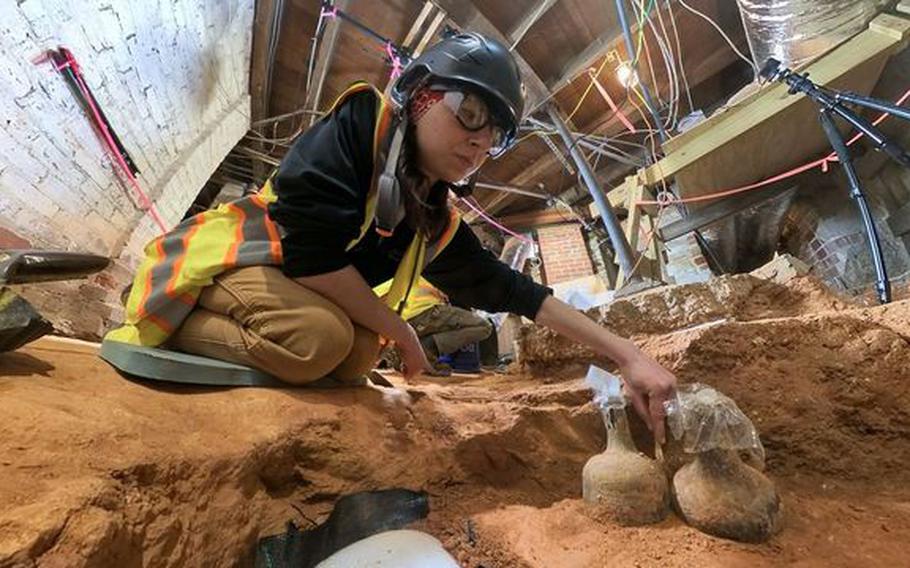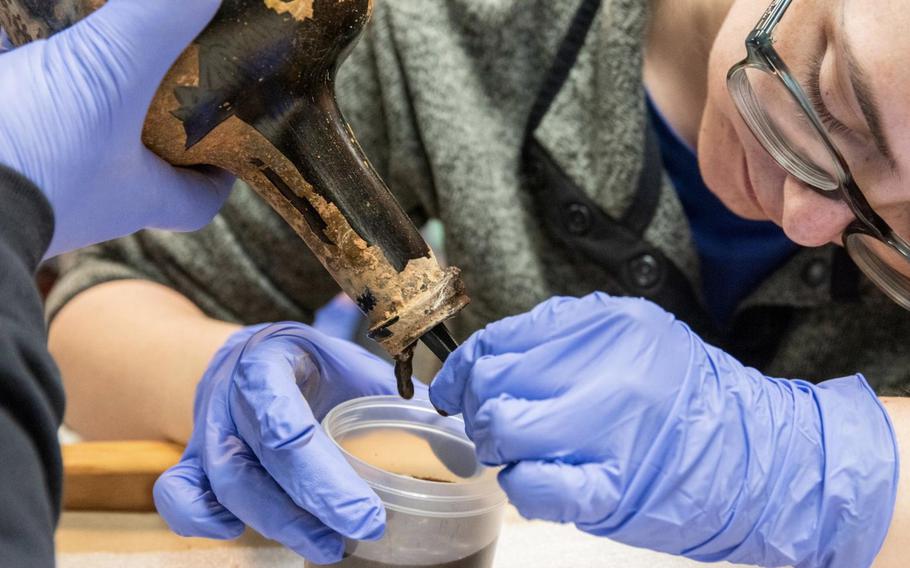
Archaeologist Tess Ostoyich carefully exposes two intact mid-18th century bottles in the Mansion cellar at George Washington’s Mount Vernon. The bottles still had, along with liquid, some of the cherries they contained when they were buried about 250 years ago. Much of the liquid could be ground water that seeped in after the cork seals deteriorated, but pits, stems, sodden cherries and gooey residue were also present, experts said. (The Mount Vernon Ladies’ Association)
Archaeologist Nick Beard was gently pushing aside the hardened dirt in the basement of George Washington’s home at Mount Vernon, Va., last fall when he spotted the mouth of a glass bottle.
Beard worked his trowel a little more and the neck of the bottle emerged. Not that unusual, he thought. Archaeologists find lots of bottle fragments.
But as he dug, more of the object appeared. “It kept [getting] larger and larger,” he said.
He stuck his finger in the mouth to see if he might wiggle the piece loose. “And my finger came back wet,” he said. “I thought about it for a half-second longer and said, ‘Oh my God, my finger is wet,’” he recalled.
“I got my flashlight out and shined it in there, and the thing is completely full of liquid,” he said.
He summoned colleagues. They were stunned. Here was “an out-of-the-box, next-level, spectacular find,” said Jason Boroughs, Mount Vernon’s principal archaeologist.
Experts at Mount Vernon said last week that Beard and other archaeologists have now discovered two intact bottles that still had, along with liquid, some of the cherries they contained when they were buried about 250 years ago. The area of the discovery was believed to have once been a storeroom, Beard said.

Archaeological Analyst Alice Keith extracting the contents of one of the approximately 250-year-old bottles recently unearthed at Mount Vernon. (The Mount Vernon Ladies’ Association)
Much of the liquid could be ground water that seeped in after the cork seals deteriorated, but pits, stems, sodden cherries and gooey residue were also present, the experts said.
“There are whole, recognizable cherries,” Boroughs said. “It actually smelled like cherry blossoms when we got to the bottom.”
Boroughs noted two other finds in Virginia of historic intact bottles containing cherries, and other fruits: one in 1966 in Williamsburg, and the other in 1981 at Thomas Jefferson’s estate, Monticello, outside Charlottesville.
“We don’t find complete objects or artifacts often ever in archaeology,” said Lily Carhart, Mount Vernon’s curator of preservation collections. “Usually we’re dealing with very tiny fragments. Where we find even the beginning of something that looks like it might be complete, that is a truly exceptional day for us.”

Lily Carhart, curator of preservation collections at George Washington’s Mount Vernon, shows historic bottles recently found buried there. The liquid and cherries inside were removed and placed in small containers, at left. ( Michael E. Ruane/The Washington Post)
The cherries were probably picked at Mount Vernon in the 1770s, perhaps before the Revolutionary War, and stored for the future. The bottles, imported from England, dated to the mid-1700s and were likely buried between 1758 and 1776, Boroughs said.
“So it’s a time capsule,” he said.
After the discovery, most of the contents were siphoned from the bottles, to help preserve the glass, and stored in fifteen small containers. The liquid and the cherries will be analyzed later, Carhart said.
At first, the archaeologists wondered if the contents might be remnants of a colonial drink called Cherry Bounce, which was made with brandy, spices, sugar and cherry juice. George Washington and his wife, Martha, were fond of it, they said.
But Boroughs said Cherry Bounce was made in much larger containers, and it is more likely that the cherries they found were preserved in the bottles for later dining.
“There are 18th century accounts that talk about proper ways of preserving fruits and vegetables,” he said. “One of the most common, especially for berries, is to dry them as much as possible … put them in a dry bottle, cork it … and then bury them.”
They would then be preserved for up to a year, he said.
The cherries were likely picked, bottled and stored by some of the hundreds of enslaved people at Mount Vernon, Boroughs said. But they were probably eaten in the main dining room, upstairs.
The archaeology was part of larger project to rehabilitate, among other things, the mansion’s deteriorated connection to its foundation, officials said.
Mount Vernon, George Washington’s famous mansion overlooking the Potomac River, is about 20 miles south of Washington. The original house was a modest structure built for his father in 1734.

George Washington’s Mount Vernon, shown in April. The mansion is about 20 miles south of Washington. (The Mount Vernon Ladies’ Association )
Washington inherited it in 1761, and expanded it dramatically over the decades — most of the work being done by those enslaved at Mount Vernon, officials said. By the time of Washington’s death in 1799 more than 300 people were enslaved on the plantation there.
Washington, who led American forces during in the Revolutionary War and became the nation’s first president, was often away from Mount Vernon, but loved the site and died there on Dec. 14, 1799.
The story of Washington, as a child, admitting to his father that he had damaged a cherry tree with a hatchet is a myth invented by an early biographer, according to Mount Vernon.
Beard, the project archaeologist, said he discovered the first bottle back in November, but excavation of that and the discovery of the second bottled did not take place until last month.
“We wanted to make sure that we would do due diligence when we excavated,” Boroughs said. But the wait was nerve-wracking, he said: “We were worried that somebody could step on it.”
When the day for the excavation came — March 22 — archaeologists and curators in hard hats and yellow safety vests gathered at the cramped site in the mansion’s basement. Using trowels and brushes, they carefully removed the hardened dirt from around the two bottles.
“We kind of actually all took turns digging them out,” Beard, the project archaeologist, recalled. “This does not happen very often, and we wanted the whole team to kind of be a part of that.”
He removed the first bottle from the ground. “My heart was racing, hands were shaking,” he said. “But I put my hands down, went for it, and it came out beautifully.”
He said he packed it in foam and carried it back to Mount Vernon’s archaeology laboratory.
“It’s been a very exciting find,” he said.
And the archaeologists think there may be more undiscovered bottles buried nearby. Excavations will continue over the next few weeks.